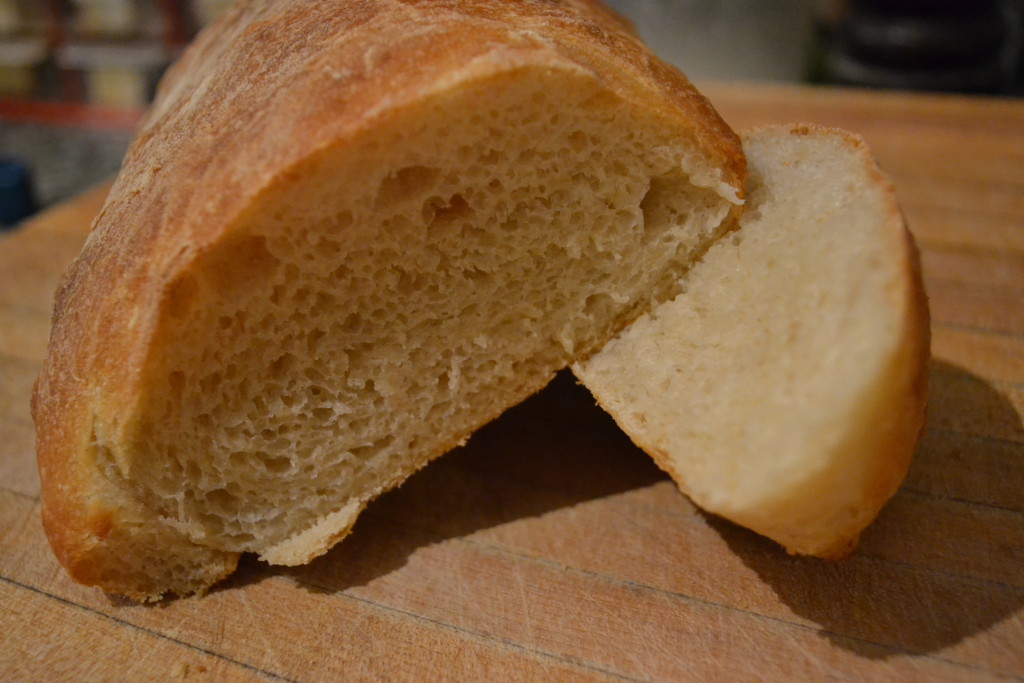On Sunday supplement
Food and Wine
We always have fresh bread around the house. Sometimes we buy it from a local bakery, but more often, it’s just something that one or both of us make every other day or so. No cultural offense intended, but the miñon that is ubiquitous on tables throughout Buenos Aires has, bluntly, the texture of a medicinal cotton ball and a flavor not much different. It amazes me, and many of my friends, that a culture so based in the history of its Italian and Spanish ancestors can mass produce such a pale imitation of the staff of life.
One of my favorites, for many uses, though especially for sandwiches (and those of you who read my blog know that I’m a sandwich fanatic), is the ciabatta, or “slipper bread”. In classic form it’s somewhat flatter than a more rustic Italian loaf, mostly due to being a very wet, soft dough, and, also is generally pinched in towards the center, almost hourglass shaped. In short, looking a bit like a bedroom slipper. The form maybe important in some presentations but isn’t key – it’s the process of making and working with a wet dough that gives this bread its unique texture.
There are two versions of the bread, one made with a starter, essentially a sourdough, the other a more “quick bread” style – and I’m going to hit you up with the latter because who among us has time to spend on making starters and all that? Now and again for a special occasion, you know? I also recommend using a mixer with a paddle attachment (rather than dough hook) – you can certainly make this bread by hand but it requires an inordinate amount of work.
Ciabatta – Slipper Bread
220 gm bread flour (000 or better yet, “harina aglutinada”)
80 gm semolina flour
300 ml warm water
1 packet dry or half cube (25 gm) fresh yeast
2 teaspoons (10 gm) salt
1 teaspoon (4 gm) sugar
In the bowl of your mixer place the warm water, sugar and yeast, give it a quick stir and leave it for a few minutes until the yeast is bubbling away. Add the flours and salt. Fit the mixer with the paddle attachment – this dough is very wet and what you need to do is beat a lot of air into it. Start the mixer slow until it is all combined – the texture will be like a thick pancake or crepe batter.
Turn the speed up to fairly high and let it go for approximately 10 minutes. By this point the gluten will have developed sufficiently that the texture will be something like marshmallow. Turn the speed down to medium and continue for another 5-6 minutes (you can, if you like, switch to the dough hook at this point, particularly if it seems like the paddle is having trouble kneading the dough) – until the dough more or less starts to “climb” up and wrap itself around the paddle or hook.
Place the dough in an oiled bowl, lightly cover with a kitchen towel and leave in a warm place to double in volume. Remove from the bowl, split the dough in two (or more if you want to make small sandwich breads), and spread each half out in a rough disk on a floured surface – don’t flatten it too much, just stretch it out to about 25-30cm across. Starting from one side and using a pastry scraper or spatula, roll the dough up from one side to the other, then place on an oiled baking sheet. If you want to make the traditional form, use a large round cutter, or scissors, and cut an arc out of each side. Cover with the towel again and leave until doubled once more.
Bake in a very hot oven (200°C or more) until browned and crisp on the outside and it should sound hollow when you tap on it. Rotate the baking sheet once or twice during the cooking so that if your oven doesn’t heat evenly on all sides the bread will cook more evenly. Remove, leave to cool, slice and enjoy.
One of our favorite things to do with one of these big loaves is treat it almost like a pizza – we slice it in half horizontally, brush it with olive oil and stick it under the broiler to get golden. Then we top it with a mix of olive oil sauteed vegetables – zucchini, eggplant, tomato, onions, peppers, chilies, olives, and perhaps a little finely chopped prosciutto (jamón crudo), some salt and pepper. We pile those on the two halves of the bread, top with a good melting cheese – cuartirolo is a favorite – and a grating of parmesan, and stick it back under the broiler to lightly brown. Makes a fantastic dinner!
A series of recipes and articles that I started writing for the Buenos Aires Herald Sunday supplement, Food & Wine section, at the beginning of 2012. My original proposal to them was to take local favorite dishes and classics and lighten them up for modern day sensibilities. We’re not talking spa or diet recipes, but at the very least, making them healthier in content, particularly salt, fat and portion size. As time went by, that morphed into a recipe column that, while emphasizing food that is relatively “good for you”, wasn’t necessarily focused on local cuisine. At the beginning of 2013 I decided to stop writing for them over some administrative issues, but it was fun while it lasted.
